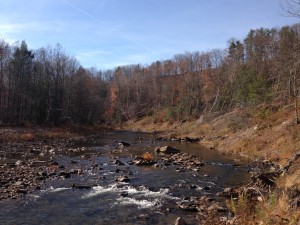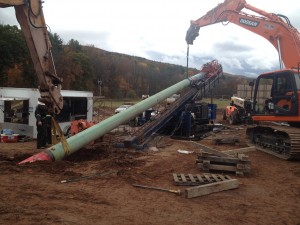Northeast PA Pipeline Project Underway
DTD is working on a natural gas pipeline in the Northeastern Pennsylvania and taking extra steps to ensure successful installation. The bore is necessary to minimize environmental effects to a high quality stream and a steep wooded hillside. The challenges of this bore are many, from the sensitive entry location (organic farm), to the long length (2,850′), the elevation change (>500′), and perhaps worst, the geology.
Glaciers covered most of northeastern Pennsylvania during the most recent ice age some 10,000 years ago. During this time, the stream valley we are drilling within was cut into a canyon with high relief, in places the steep walls approached 500′ high. As the glaciers melted, sediment partially filled the canyon, and more sediment was draped on the canyon walls; leaving the stream valley we see today. A broad flat bottomed valley, with a small stream flowing over sandy gravel, cobble and boulder. The picture at right shows the stream… however, if you were to dig here looking for bedrock, you would have over 50′ of gravel and cobble to dig before you got to bedrock. The right stream bank is also composed of glacially deposited sediment that rises over 100′ above the stream, and a careful look shows the trees at an angle as the sediment supported hill slope has had land slide failures in recent years.
Safely and accurately drilling in this type of setting (gravel and cobble) is either very difficult, or impossible. In attempt to minimize risk to the environment, the bore profile was adjusted, and a 20″ diameter surface casing was hammered all the way to bedrock.
As could be expected, the surface casing proved to be a necessary. Without the casing, drilling initially progressed in a satisfactory manner, but after ~80′ the bore began to collapse on itself. After a failed attempts to clean the annulus, the surface casing was driven down to bedrock and eliminated the collapsing conditions.
The 20″ diameter casing was driven with a pneumatic air hammer capable of hitting with 2.4 million lbs of force. A “sled” was fabricated that allowed the rig to guide and align the casing. The casing driving process is slow and steady work, and from start to finish required almost a week, but will allow the completion of a bore that either may not have been completed without significant risk to the environment.

